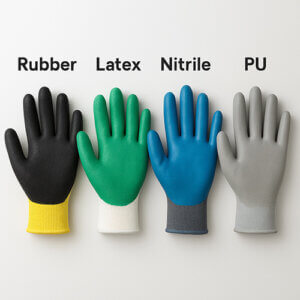When it comes to safety gloves, the coating is what truly defines their protection, durability, and comfort.
Each coating type offers unique advantages — some provide stronger grip, others resist oil and chemicals, while some are light and breathable.
In this guide, CHEAMY explains the key differences between rubber, latex, nitrile, and PU coatings, so you can easily find the best gloves for your work.
1. Rubber Coating – Strong Grip and Great Value
Rubber-coated gloves are one of the most common and budget-friendly types, known for their excellent grip.
Features:
-
Strong anti-slip performance, even in wet conditions;
-
Durable and tear-resistant, ideal for heavy use;
-
Cost-effective and practical for general labor.
Limitations:
-
Low breathability;
-
Not oil-resistant (rubber may degrade when exposed to oil).
Best for: Construction, material handling, gardening, and maintenance work.

2. Latex Coating – Soft, Flexible, and Excellent Grip
Latex-coated gloves are known for their elasticity and comfort, offering a snug fit for the hands.
Features:
-
High elasticity and softness for natural hand movement;
-
Strong wet and dry grip, suitable for slippery surfaces;
-
Comfortable for long-time use.
Limitations:
-
Not suitable for users allergic to latex;
-
Poor oil and chemical resistance.
Best for: Assembly, warehouse work, gardening, and general maintenance.

3. Nitrile Coating – The Oil-Resistant Power Performer
Nitrile is a synthetic rubber that stands out for its oil and chemical resistance, making it the top choice for industrial environments.
Features:
-
Excellent resistance to oils, solvents, and chemicals;
-
Superior durability, puncture, and abrasion resistance;
-
Flexible yet sturdy, offering a secure fit.
Limitations:
-
Slightly stiffer than latex;
-
Slightly higher cost.
Best for: Automotive, metal fabrication, chemical handling, and cleaning tasks.

4. PU Coating – Lightweight and Breathable for Precision Work
PU (Polyurethane) coated gloves are known for their dexterity and comfort, perfect for fine tasks.
Features:
-
Exceptional flexibility and tactile sensitivity for precision handling;
-
Breathable and comfortable for long hours;
-
Smooth, anti-slip surface for better control.
Limitations:
-
Not oil-resistant;
-
Less durable in heavy or abrasive environments.
Best for: Electronics, inspection, packaging, laboratory work, and light industry.

5. Quick Comparison Chart
| Coating Type | Main Advantages | Limitations | Ideal Applications |
|---|---|---|---|
| Rubber | Excellent grip, durable, cost-effective | Not breathable, not oil-resistant | Construction, material handling |
| Latex | Soft, flexible, strong wet grip | Latex allergy risk, not oil-resistant | Assembly, warehouse, gardening |
| Nitrile | Oil & chemical resistant, durable | Slightly stiff, higher cost | Automotive, chemical, cleaning |
| PU | Lightweight, breathable, flexible | Not oil-resistant, moderate durability | Electronics, precision work |
6. How to Choose the Right Coating
-
Working with oils or solvents? → Choose Nitrile coating.
-
Need flexibility and breathability? → Go for PU coating.
-
Wet or slippery environment? → Latex coating offers the best grip.
-
Looking for durability and value? → Rubber coating is the practical choice.
At CHEAMY, we provide a wide range of coated gloves designed for different working conditions — ensuring both safety and comfort for your team.
We provide more than PPE products — we provide safety.








